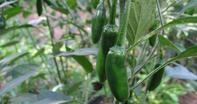
Propagation
Chilli propagation is from seedsPlanting Method
Seeds can be directly sown but this is not generally the practice of farmers. The seeds are sown in prepared beds or in seed trays in protected areas or in greenhouses. The seeds germinate and seedlings are made.
Once the seedlings are established and about 15+ cm tall and strong enough they are transplanted into the open field or into a prepared medium used in greenhouses. The use of either organic or plastic mulching on the plant rows reduces evaporation, controls weeds and warms and regulates soil temperatures.
Spacing
Small bush varieties are spaced 30 cm apart in rows that are 50 cm apart in tram lines to provide a slightly wider space every two rows for implements and workers to move through and for sunlight.
Larger plant varieties are spaced 50 cm apart in rows that are 60 to 75 cm apart. This requires about 20 000 to 50 000 plants per hectare depending on the spacing and pepper variety decided on by the grower.
Sowing Time
In a protected environment like a greenhouse or where the late winter and spring temperatures are warmer the sowing of chilli seeds can begin in July.
When making seedlings outside in the open or direct sowing, the seeds are sown late August and September to miss the spring cool weather.
Planting Time
About five to six weeks after sowing of the chilli seeds the seedlings can be transplanted out when they are between 15 and 20 cm in size.
Choose only the strongest plants and try to choose plants uniform in size. This will normally be late July in warm climates to mid September. Planting can however be done till the end of November as long as the autumn temperatures are not too cool.
Growth Period
From seed to the first green chilli peppers being ready for harvest can take up to sixteen weeks. For fresh red chilli peppers it takes about five to six months, and if the plants are left for the harvest of dry red chilli peppers, about six to eight months from seeds being planted, depending on the weather. Dry red chilli peppers can only be produced in areas where it is warm and no chance of rain on the bush-drying chilli peppers.Fertilization
It is always advisable to have the soil properly analyzed by your extension service and soil nutritional advisor before planting. A general guide to fertilizing your chilli peppers is as follows.
Make sure the land is properly ploughed and levelled. During the final ploughing, done normally with a disc plough or rotavator apply a pre-planting fertilizer application of between 500 and 800 kilograms of 2:3:4 (30) (a mixture of Nitrogen, Phosphates and Potassium) into the top 20 cm of soil.
If drip irrigation is used, it is better to apply the equivalent in a liquid fertilizer through the water over the first 4 weeks of growth and thereafter throughout the growing period to when harvesting of the first green chilli peppers starts.
For sprinkler or flood irrigation apply about 250 kg of LAN per hectare at about 6 weeks after planting. This second application can be split into two 150 kg applications at six and again eight weeks from planting.
Irrigation
After planting irrigate about 15 mm per week for the first three weeks thereafter irrigate between 30 and 40 mm of water per week throughout the growing period.
It is advisable to install moisture tension meters to monitor soil moisture. Most of the roots are concentrated in the top 40 cm of soil so a shovel or hand auger can be used to check the soil.
The best irrigation system is drip irrigation under plastic mulching as this gives the farmer more control over the irrigation and fertilizing of his crop.
Mulching also controls weeds and reduces evaporation. Flood irrigation can lead to waterlogged or dry conditions as it is more difficult to manage. Overhead irrigation can cause fungal disease and rot.
By Louise Brodie